

WHAT. University/SME collaboration. Universities and research centres can help form so-called systems and networks of innovation.
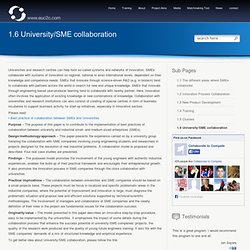
SMEs collaborate with systems of innovation on regional, national or even international levels, dependant on their knowledge and competence needs. SMEs that innovate through science-driven R&D (e.g. in biotech) tend to collaborate with partners across the world in search for new and unique knowledge. SMEs that innovate through engineering based user-producer learning tend to collaborate with nearby partner. Here, innovation often involves the application of existing knowledge or new combinations of knowledge. WHY. Why Collaborate? “Collaborate or die” An exaggeration?
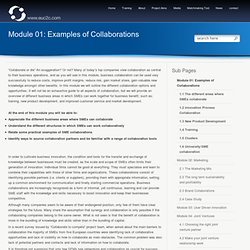
Or not? Many of today’s top companies view collaboration as central to their business operations, and as you will see in this module, business collaboration can be used very successfully to reduce costs, improve profit margins, reduce risk, gain market share, gain valuable new knowledge amongst other benefits. In this module we will outline the different collaboration options and opportunities. It will not be an exhaustive guide to all aspects of collaboration, but we will provide an overview of different business areas in which SMEs can work together for business benefit, such as; training, new product development, and improved customer service and market development. At the end of this module you will be able to:
Case Study - Cogent Power Ltd & Cardiff University. Benefits and barriers of collaboration. How to Reach Agreement.pdf. Book Summary of The Consensus Building Handbook: A Comprehensive Guide to Reaching Agreement by Lawrence Susskind, Sarah McKearnan and Jennifer Thomas-Larmer, eds. Susskind, Lawrence, Sarah McKearnan and Jennifer Thomas-Larmer, eds. . Thousand Oaks, CA: Sage Publications, 1999, 1147 pp. This Book Summary written by: Conflict Research Consortium Staff This text is intended to serve as a reference text, documenting best practices in the field of consensus building. It is designed to be accessible and informative for both practitioners and a broader audience. The text includes an overview of guidelines for consensus building, chapters examining various phases and types of consensus building in more detail, an extensive selection of case studies, brief biographies of the contributing authors, a selected bibliography, and a comprehensive index to the text.
Part One offers an abbreviated step-by-step guide to the consensus building process. Part Two consists of seventeen chapters; each contributed by an expert in the field, and each discussing an aspect of consensus building in greater detail. Setting Objectives. Writing SMART Goals and Objectives Webinar. Lambert Tool kit for Collaborative Research. The Lambert toolkit is for universities and companies that wish to undertake collaborative research projects with each other.
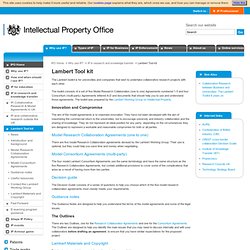
The toolkit consists of a set of five Model Research Collaboration (one to one) Agreements numbered 1-5 and four Consortium (multi-party) Agreements lettered A-D and documents that should help you to use and understand those agreements. The toolkit was prepared by the Lambert Working Group on Intellectual Property. Innovation and Compromise The aim of the model agreements is to maximise innovation.
Model Research Collaboration Agreements. There are five model Research Collaboration Agreements, covering one to one projects each providing a different approach in the key area of who is to own, and have the right to exploit, the intellectual property in the results or outcome of the collaborative project.
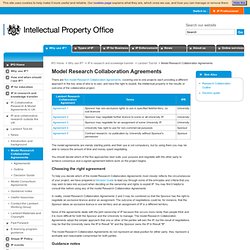
The model agreements are merely starting points and their use is not compulsory, but by using them you may be able to reduce the amount of time and money spent negotiating. You should decide which of the five approaches best suits your purpose and negotiate with the other party to achieve consensus and a signed agreement before work on the project begins. Choosing the right agreement To help you decide which of the model Research Collaboration Agreements most closely reflects the circumstances of your project, we have prepared a Decision Guide to lead you through some of the principles and criteria that you may wish to take into account when deciding on the ownership and rights to exploit IP. Guidance notes Identifying issues. Model Research Collaboration Outline.
Responsible Partnering Initiative and University-Business Collaborative Research. Europe’s universities are increasingly developing partnerships in their research and innovation missions, embracing the “Open Innovation model” of university-business collaboration and seeking to embed this is in sound project management and improved intellectual property management that reflects respective interests.
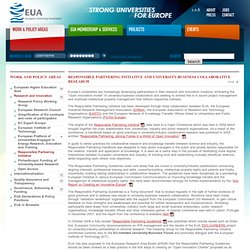
The Responsible Partnering Initiative has been developed through close collaboration between EUA, the European Industrial Research Management Association (EIRMA), the European Association of Research and Technology Organisations (EARTO) and the European Network of Knowledge Transfer Offices linked to Universities and Public Research Organisations (ProTon Europe). The origins of the Responsible Partnering Initiative date back to a major Conference which was held in 2004 which brought together the main stakeholders from universities, industry and public research organisations.
In October 2009 a fully revised 'Responsible Partnering Guidelines' Responsible_Partnering_Guidelines. SME video case study working with a HEI. University video case study working with an SME.